How to test and use your EE-8 field phones
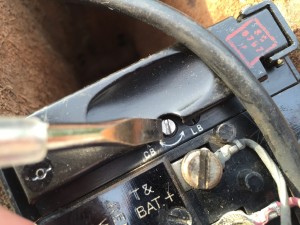
First make sure that screw switch is turned to LB
As a little summer project, I bought a set of EE-8-B field phones and put them to the test, following the procedures in TM 11-333. This article covers the bits of it you need to know to test if yours works (even if you only have one). And if it does, you can try finding another one. These phones are really sturdy, so there’s a good chance you’ll have a working one. The main thing you’ll want to check for is that the batteries haven’t leaked (corrosion on the battery springs). I have one like that, so not top-grade, but apparently it still works.
The first step is to make sure the phone is set to LB (Local Battery) mode. This is the small screw next to the lever switch. Test with a screwdriver if it’s turned all the way counterclockwise to LB.
This article has been online for almost 10 years now, and sometimes new insights come to light. Richard Jaeger says he tells people that LB stands for ‘Loud Bell’. It does not according to the manual, but there’s some sense to it because when set to LB mode, the bell rings loudly, whereas in CB (Common Battery) mode, the bell is silent.
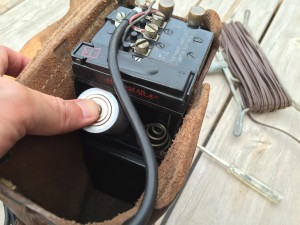
Insert batteries at an angle as shown here
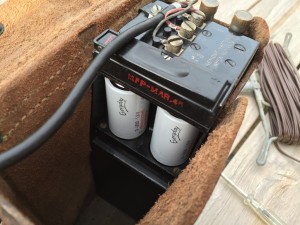
With both batteries in place
Then insert the batteries. That turned out to be tricky. At first I thought my modern D-cell batteries were too tall. I just couldn’t get them in. In this photo you see how to first place the bottom of the battery on the battery spring at an angle. While still at this angle, press the battery down. You should feel the spring moving down. Then push the battery inside and straight.
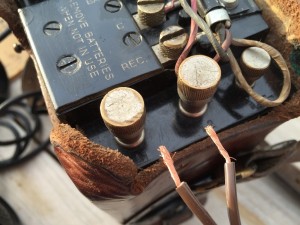
Strip the wire as shown and insert into L1 and L2
Then attach the wire. First strip the ends and then screw them into the line binding posts marked L1 and L2. For the preliminary testing, only connect 1 phone. We’ll get to connecting the second one further down.
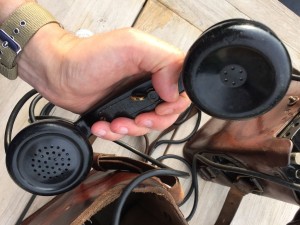
Operate lever on handset to talk
Now hold the receiver to your ear and blow into the transmitter while alternately operating and releasing the handset switch. The sound (sidetone) should be heard in the receiver when the switch is in operated position, but should not be heard when the switch is released.
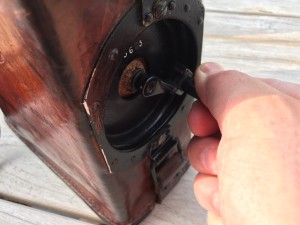
Turn generator clockwise. Hear pulse in headset.
Next, hold the handset to your ear and turn the generator clockwise several times. The generator should turn easily and you should hear pulses in the receiver. The ringer should not operate.
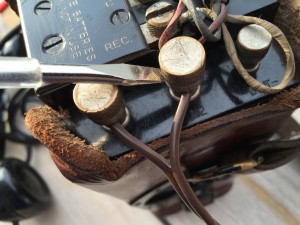
Short circuit L1 and L2. You’ll feel drag on generator.
When that works, short circuit the line terminals L1 and L2, for example with a screwdriver, as in the photo. The generator should now turn hard, as if a drag were placed on it, and the bell should not ring.
Finally, after repeating the steps above on the second phone, connect both phones. It doesn’t matter which side of the wire goes into L1 or L2. Good thing too, because you wouldn’t know which side is which after unrolling a mile-long cable. Turn the generator, and the ringer should sound on the other phone! Press the lever on the handset to talk and release to listen.
Now you’re thinking “what’s that big lever switch for?” This has no function in LB-mode. It is used to hang the handset on when connected to a central battery in a switchboard set-up.
Attention: always remove the batteries when not in use! It says so on the top cover, and for a reason. If the talking lever on the handset is depressed when packed inside the case for storage or transportation, this will drain the batteries.
What kind of wire to use
Though very reliable, the main drawback of field phones is the need of long cables and moving the cables as the front moves. As testified in many unit histories, cables could break, thus cutting off communications. A linesman would have to be sent to find where it broke and repair it. All sorts of equipment exists for carrying and laying cables. In the photos above you see the smallest type of reel for about 200 yards of wire, but they existed in various sizes. A mile-long reel could be carried on a chest-harness, and larger reels existed and could be towed by a special hand cart or on a special rack behind a jeep.
For re-enactment it would be a pity to use original wire, but nearly identical military grade field phone wire can be obtained from surplus stores. It is made of 2 strands of copper wire, reinforced with steel wire to prevent breakage. The wire in the photos above is not authentic and only used for testing.
Forget the SCR-536/BC-611 “Handie Talkie” you always see in the movies. These things never worked when you needed them, they require a custom-built 90v battery (!), the range is only a mile or two, and telecommunication laws in Europe prohibit the use of them anyway. For fun re-enactment bring in the EE-8 field phone! It only requires 2 D-cell 1,5v batteries and the range of 11 miles is more than you’ll ever need. And all perfectly legal.
And yes, paratroopers did use them a lot too 😉

My set of EE-8-B field phones
Switchboards
This last picture was taken at the Bastogne Barracks museum. At McAuliffe’s headquarters of the 101st, you see plenty of wires coming into the switchboard from all over the Bastogne perimeter. You’ll need one of those if you want to build a communications network of more than 2 phones.
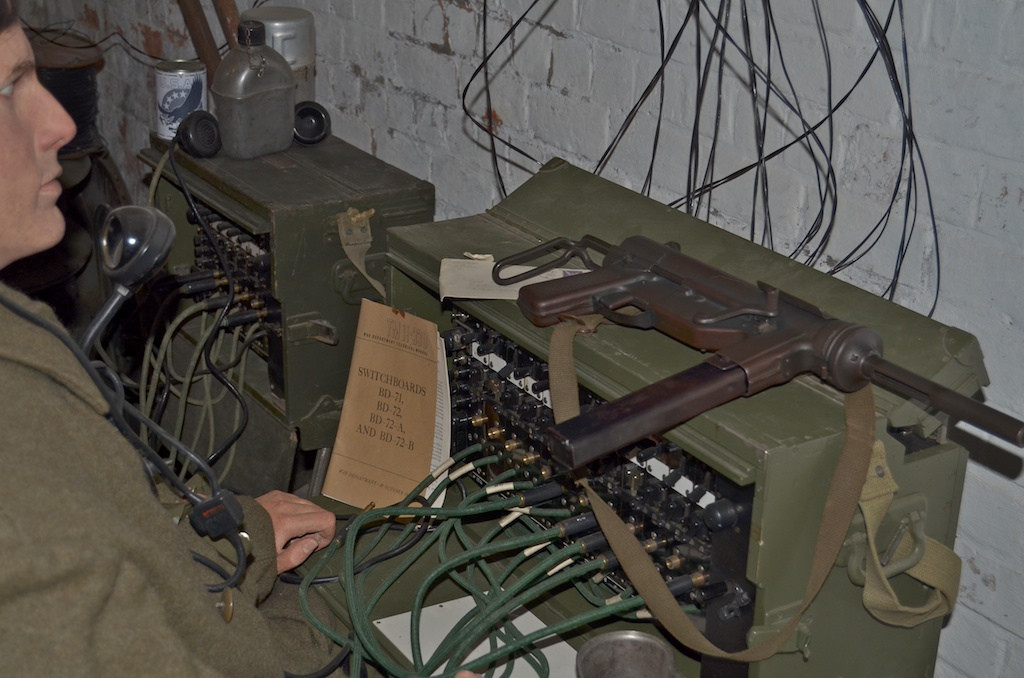
Switchboard operator at 101st Airborne HQ in Bastogne
Download a PDF of TM 11-333 from Radionerds.com
Military Field Phones Collectors Group
In October 2023, I got an email from the Military Field Phones Collectors Group, who have a Facebook group, which you can join if you’re interested in the technology and use of field phones from different periods and countries, and a YouTube Channel with lots of interesting videos about field phones:


Hello,
I yesterday got the phone EE-8, do you know where to get batteries for that?
Thank you and best greetings from Germany, Bavaria,
Hans
Hi Hans, these are common D-cell batteries that you can buy at any store selling household batteries.
I have a pair if ee-8 field phones. I am having a hard time making the
Positive side of the battery to align with post to make a good contact. Is there something I can install like a cap so that the positive side of the battery stays in place. Right now I have take the phone out of the case to assure batteries stay aligned.
Thanks
Pete Unwin
Hi Peter, I don’t quite see what you mean. But feel free to send me a photo at paratrooper.be@gmail.com. It’s a simple device so it shouldn’t be hard to fix.
What date and place do you need EE-8 field phones for?
I also have a DR-8 reel of wire and a couple of working post WW-2 war german field phones if you need them.
Don Helgeson here. I have helped out other military minded folks with displays of ECM for the OLD CROWS and helped out Tom Aschenbrener with parts for USS COBIA up at The Wisconsin Maritime Museum.
My only payment would be in memory of my cousin, The Late Louie Larsen who was badly wounded at “Bastone”.
Dear sir, I’m not sure what your question is. You are selling these items? I’m not interested myself as I already have these items, but maybe someone else reading this may be interested. Have a nice day
Hi. I have a very nice set of EE-8 field phones. They both work but one is a little louder than the other. The earpiece that is. Is there a way to make it a little louder? Thank you
Pat.
Hello Pat, I made some enquiries for you. The sound in the earpiece depends on the power from the 2 D-cell batteries. I’m sure you already that those are properly charged. More likely, there is corrosion somewhere on the contact of the weaker sounding telephone. Look for that and try to gently sand it off in order to obtain a better contact. Here’s also a link to a PDF of the field manual for the EE-8 telehone: http://www.easy39th.com/files/TM_11-333_Telephones_EE-8,_EE-8-A_and_EE-8-B_1950.pdf I hope this helps. Have fun!
are those for sale?
No, I’m sorry. I’m keeping them.
I’m having a problem where I can hear myself speaking through one of the phones but I can’t hear anything through the other phone. Do you know how I could fix this?
I don’t know Lucas, but let’s post it here. Maybe someone else can help.
Just picked op a pair of EE-8s, one in leather, the other in canvass. The leather one has a toggle switch on the handset, the other has a button. are these send/receive switches?
Also, the leather has no insignia embossed into it, as I’ve seen in photos. Any info would be great. I’ve already learned a lot from your site, thanks.
I don’t know, but it could be these ar post-war or even French post-war production if they have no markings on the leather.
The Canvas one is probably from the korean war. EE-8s were used from WW2 to vietnam and they changed the bag types multiple times. As for the button, my two korean war ones have switches, so no clue there. Could be a post production edit.
EE-8s came out with heavy waxed canvas cases during WWII after the Marines experience fighting on Guadacanal. So as the war progressed the EE8s that went to the South Pacific were generally the canvas covers with a heavy was seal. Leather ones generally went to Europe or N Africa because the leather would hold up. During the Viet Nam conflict the USMC was still using EE8s and by this time there went to a type of rubberized case that was fairly flexiable.\
My handset wires are badly decayed, any idewa where I could get replacements? Or, what they’re called?
Thanks
Hello Aaron, I don’t know, but did you have a look at the link to the technical manual in my article? Here it is to be sure, because it’s hidden in the comments: http://www.easy39th.com/files/TM_11-333_Telephones_EE-8,_EE-8-A_and_EE-8-B_1950.pdf
I hope this helps!
My EE-8 in the canvas case has a handset( not attached) with a button instead of a butterfly switch. Is this authentic?
Thanks
Hi; Iam looking for a ww2 Ba-30 battery, or two.
I have 2 EE-8A I’m having a issue with getting them to ring. The one will ring sometimes but the other not at all. The striker on both move freely. Is there anything I should look for??
Hello John, it sounds like a lack of tension or a bad connection somewhere, but I’m not a technician myself. Have you had a look at the manual? Here’s the download link: http://radionerds.com/images/6/66/TM-11-333.pdf
Is there a way to make a single unit ring the bell while turning the crank?
Helpful post! I used your instructions to tie our lone EE-8 into two other (civilian) crank phones we already had set up as a network. Worked like a charm using regular phone wire (carefully stripped/spliced). One last question: How do you date these units? Besides the leather vs. canvas carrier, I see no indication or manufacturer markings that would give a date. Any tips? Thanks!
Hello Tom, good for you! They are fun, aren’t they? That’s a good question about the dates. I don’t know, but I will have a closer look at the ones I have to see if I can find a date anywhere. According to this discussion you would have to unscrew the phone from the leather case to maybe find a paper tag that maybe has a manufacturing year on it. I am not going to do that with mine, but I’ll try unscrewing the earpieces to see if I can find a year on the components. https://www.usmilitariaforum.com/forums/index.php?/topic/210579-date-marking-on-ee-8-b-telephone/
Hi Tom, I checked the 3 phones I have: 1 has a date on the component in the earpiece (45), two others in the mouth piece: APR 72 and MAR 80. I almost wish I hadn’t looked, because now it seems all three of them are probably originally wartime phones, but were reconditioned post-war. Do you see the same on yours? Wouter
Great recap and thanks for the link to the manual !
You’re welcome Pat!
Hello,
I recently bought two EE-8 at an army surplus store, the wires have been removed and the existing wire were exposed and cracking. I have since then rewired the phone cord( I’m hoping the internal wirings are still good), the only trouble I have is that the phone wiring is a bit confusing. I just don’t seem to understand the wiring inside, could you send a photo or walk me throughout the steps?
Thanks
Cade East
Hello Cade, that sounds complicated. I have never touched the wiring myself. The phones I have worked when I bought them. I can have a look if I can open one up and take pictures of the wiring. I would be surprised if anything was wrong with the internal wiring though. It’s well protected and the case is very sturdy.
Are your referring to the wires that connect the handset to the phone unit in the case?
I recently picked up 2 EE-8-a phones
One works flawlessly (phone A)but the other (Phone B), only rings sometimes. If you connect them together (or another phone) and crank the handle on the other working phone(phone A), the bell sometimes rings on Phone B) but will stop working for sometime after cranking the handle to call the other phone (cranking handle on phone B will ring Phone A every time but then phone A calling will not cause the bell on phone B to ring)
Seems to work after leaving it for 20 mins though
Is it simply a lose connection?
Hello Peter, I wouldn’t know. It sounds like a bad connection somewhere. But maybe another reader can help you out.
I just got one that’s in pretty rough shape. Do you know if there’s somewhere I can get replacement leather case or new phone wires?
Hello Richard, I have never seen a leather case on the loose. You’re probably better off buying another set to cannibalize for parts.